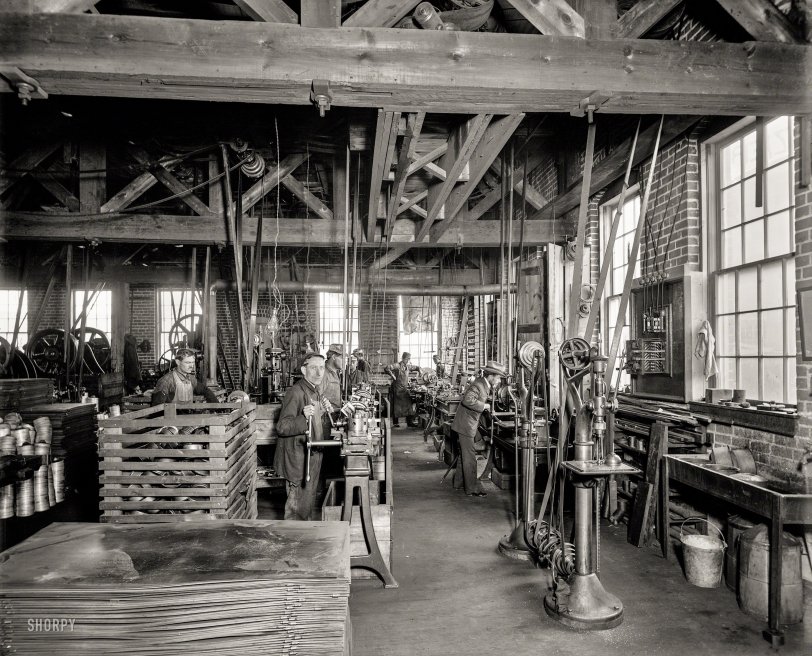


Framed or unframed, desk size to sofa size, printed by us in Arizona and Alabama since 2007. Explore now.
Shorpy is funded by you. Patreon contributors get an ad-free experience.
Learn more.

- Texas Flyer wanted
- Just a Year Too Soon
- WWII -- Replacing men with women at the railroad crossing.
- Yes, Icing
- You kids drive me nuts!
- NOT An Easy Job
- I wonder
- Just add window boxes
- Icing Platform?
- Indiana Harbor Belt abides
- Freezing haze
- Corrections (for those who care)
- C&NW at Nelson
- Fallen Flags
- A dangerous job made worse
- Water Stop
- Passenger trains have right of way over freights?
- Coal
- Never ceases to amaze me.
- Still chuggin' (in model form)
- Great shot
- Westerly Breeze
- For the men, a trapeze
- Tickled
- Sense of loneliness ...
- 2 cents
- Charm City
- What an Outrage
- Brighton Park
- Catenary Supports
Print Emporium
Capitalist Tools: 1901

Chelsea, Michigan, circa 1901. "Glazier Stove Company, machine room." 8x10 inch dry plate glass negative, Detroit Publishing Company. View full size.
The well-equipped shop -- but not for long
Looking around the floor here I see three drill presses, four lathes, two turret lathes, and an arbor press being used by our boss-type person. The real action is at the big stamping presses over in the back left, though, judging from the pile of sheet metal and crate of stamped parts.
Glazier fancied himself quite the magnate and he dabbled/interfered heavily in local politics. However in the panic of 1907 he was caught short on a loan, and this attracted the attention of his Detroit bankers, who sent auditors. They discovered that there was nothing to audit because his wife had burned the company books in the spring. This set off bankruptcy and embezzlement cases which eventually landed Glazier in jail for a few years until he was pardoned for ill-health; he lived another decade, dying in 1922.
Motor Starter
The device between the windows is most likely the 3-point (or 4-point) starter for the DC motor that drives the belts. The arm is in the off position in the photo, driven there by a hefty spring. When running the arm is held in position against the spring tension by the electromagnet that you can see near the top center of the device.
Frozen in time
There's some kind of variable controller - probably a speed controller for an electric motor, but maybe also a light dimmer - over there on the right, between the windows. It seems to be pretty close to one end of its range - either all the way on or all the way off. It could be a dimmer - the lights are shut off for this daytime photo. However, I think it's a speed controller, and it's set at or close to zero, as we'd probably see a lot more motion blur on the leather belts if all the shafts were turning.
40 years before this picture, all of those belts would have been driven by a steam engine or a mill wheel. By the time of this photo, there might be a big electric motor or three driving all of them. Right around this time, electrical engineers were starting to apply actual math to designing motors, instead of the previously popular "cut and try, and write down the ones that work". 20 years later, the motors would be small enough that each individual tool could have one.
Also, that guy on the right is amazingly well-dressed for a machinist.
The boss?
The dapper little man in dressed in a suit and a hat on the right. In any event, strange garb to be wearing working at a machine tool.
Ringer
The guy on the right, with the suit and the fedora, doesn't look like he belongs. Maybe the owner, posing for he camera?
Take your boss to work day?
The guy on the right must be the owner, and decided that he was going to be in the picture.
























On Shorpy:
Today’s Top 5